Exploring Consumers’ Understanding and Perception of Sustainable Food Packaging in the UK
Abstract
:1. Introduction
2. Materials and Methods
2.1. Study Information
2.2. Study Design
2.3. Statistical Analysis
3. Results
3.1. Demographics and Recycling Behaviour
3.2. Sustainability Habits and Knowledge
3.3. Impact of Labelling on Behaviour
3.4. Key Sustainable Food Packaging Attributes
4. Discussion
4.1. Sustainability Habits and Knowledge
4.2. Impact of Labelling on Behaviour
4.3. Key Sustainable Food Packaging Attributes
5. Conclusions
Author Contributions
Funding
Institutional Review Board Statement
Informed Consent Statement
Data Availability Statement
Acknowledgments
Conflicts of Interest
References
- Marsh, K.; Bugusu, B. Food packaging—Roles, materials, and environmental issues. J. Food Sci. 2007, 72, 39–55. [Google Scholar]
- Ares, G.; Deliza, R. Studying the influence of package shape and colour on consumer expectations of milk desserts using word association and conjoint analysis. Food Qual. Prefer. 2010, 21, 930–937. [Google Scholar]
- Otto, S.; Strenger, M.; Maier-Nöth, A.; Schmid, M. Food packaging and sustainability—Consumer perception vs correlated scientific facts: A review. J. Clean. Prod. 2021, 298, 126733. [Google Scholar]
- Food and Agriculture Organization of the United Nations. Available online: https://www.fao.org/fao-stories/article/en/c/1441299/ (accessed on 1 June 2022).
- Magnier, L.; Crie, D. Communicating packaging eco-friendliness. Int. J. Retail. Distrib. Manag. 2015, 43, 350. [Google Scholar]
- Parliamentary Office of Science & Technology. Available online: https://post.parliament.uk/research-briefings/post-pn-0605/ (accessed on 4 June 2022).
- Oloyede, O.O.; Lignou, S. Sustainable paper-based packaging: A consumer’s perspective. Foods 2021, 10, 1035. [Google Scholar]
- Nordin, N.; Selke, S. Social aspect of sustainable packaging. Packag. Technol. Sci. 2010, 23, 317–326. [Google Scholar]
- Herbes, C.; Beuthner, C.; Ramme, I. Consumer attitudes towards biobased packaging—A cross-cultural comparative study. J. Clean. Prod. 2018, 194, 203–218. [Google Scholar]
- Boesen, S.; Bey, N.; Niero, M. Environmental sustainability of liquid food packaging: Is there a gap between Danish consumers’ perception and learnings from life cycle assessment? J. Clean. Prod. 2019, 210, 1193–1206. [Google Scholar]
- Lindh, H.; Olsson, A.; Williams, H. Consumer perceptions of food packaging: Contributing to or counteracting environmentally sustainable development? Packag. Technol. Sci. 2016, 29, 3–23. [Google Scholar]
- Ketelsen, M.; Janssen, M.; Hamm, U. Consumers’ response to environmentally-friendly food packaging—A systematic review. J. Clean. Prod. 2020, 254, 120123. [Google Scholar]
- Giancristofaro, R.A.; Bordignon, P. Consumer preferences in food packaging: CUB models and conjoint analysis. Br. Food J. 2016, 118, 527–540. [Google Scholar]
- Grunert, K.G. Consumer reactions to on-pack educational messages. In Integrating the Packaging and Product Experience in Food and Beverages—A Road-Map to Consumer Satisfaction; Burgess, P., Ed.; Woodhead Publishing: Cambridge, UK, 2016; pp. 23–35. [Google Scholar]
- Simmonds, G.; Spence, C. Thinking inside the box: How seeing products on, or through, the packaging influences consumer perceptions and purchase behaviour. Food Qual. Prefer. 2017, 62, 340–351. [Google Scholar]
- Orzan, G.; Cruceru, A.F.; Balaceanu, C.T.; Chivu, R.G. Consumers’ behavior concerning sustainable packaging: An exploratory study on romanian consumers. Sustainability 2018, 10, 11. [Google Scholar]
- Nguyen, A.T.; Parker, L.; Brennan, L.; Lockrey, S. A consumer definition of eco-friendly packaging. J. Clean. Prod. 2019, 252, 119792. [Google Scholar]
- Cutter, C.N. Opportunities for bio-based packaging technologies to improve the quality and safety of fresh and further processed muscle foods. Meat Sci. 2006, 74, 131–142. [Google Scholar] [PubMed]
- Koutsimanis, G.; Getter, K.; Behe, B.; Harte, J.; Almenar, E. Influences of packaging attributes on consumer purchase decisions for fresh produce. Appetite 2012, 59, 270–280. [Google Scholar]
- Duizer, L.M.; Robertson, T.; Han, J. Requirements for Packaging from an Ageing Consumer’s Perspective. Packag. Technol. Sci. 2009, 22, 187–197. [Google Scholar] [CrossRef]
- Chandra Lal, R.; Yambrach, F.; McProud, L. Consumer perceptions towards package designs: A cross cultural study. J. Appl. Packag. Res. 2015, 7, 4. [Google Scholar]
- Attiq, S.; Habib, M.D.; Kaur, P.; Hasni, M.J.S.; Dhir, A. Drivers of food waste reduction behaviour in the household context. Food Qual. Prefer. 2021, 94, 104300. [Google Scholar]
- Lawless, H.T.; Heymann, H. Sensory Evaluation of Food—Principles and Practices, 2nd ed.; Springer: New York, NY, USA, 2010; pp. 149–177. [Google Scholar]
- Meyners, M.; Castura, J. Check-all-that-apply questions. In Novel Techniques in Sensory Characterization and Consumer Profiling; Varela, P., Areas, G., Eds.; CRC Press: Boca Raton, FL, USA, 2014; pp. 271–305. [Google Scholar]
- Ennis, J.M.; Jesionka, V. The power of sensory discrimination methods revisited. J. Sens. Stud. 2011, 26, 371–382. [Google Scholar]
- Dilkes-Hoffman, L.S.; Pratt, S.; Laycock, B.; Ashworth, P.; Lant, P.A. Public attitudes towards plastics. Recour. Conserv. Recycl. 2019, 147, 227–235. [Google Scholar] [CrossRef]
- Two Sides. Available online: https://www.twosides.info/packaging2020/ (accessed on 4 June 2022).
- Lignou, S.; Oloyede, O.O. Consumer acceptability and sensory profile of sustainable paper-based packaging. Foods 2021, 10, 990. [Google Scholar] [CrossRef] [PubMed]
- Taufik, D.; Reinders, M.J.; Molenveld, K.; Onwezen, M.C. The paradox between the environmental appeal of bio-based plastic packaging for consumers and their disposal behaviour. Sci. Total Environ. 2020, 705, 135820. [Google Scholar] [CrossRef] [PubMed]
- Jezewska-Zychowicz, M.; Jeznach, M. Consumers’ behaviours related to packaging and their attitudes towards environment. J. Agribus. Rural Dev. 2015, 3, 447–457. [Google Scholar]
- Jerzyk, E. Design and communication of ecological content on sustainable packaging in young consumers’ opinions. J. Food Prod. Mark. 2016, 22, 707–716. [Google Scholar] [CrossRef]
- Sijtsema, S.J.; Onwezen, M.C.; Reinders, M.J.; Dagevos, H.; Partanen, A.; Meeusen, M. Consumer perception of bio-based products—An exploratory study in 5 European countries. NJAS Wagening J. Life Sci. 2016, 77, 61–69. [Google Scholar] [CrossRef]
- van Birgelen, M.; Semeijn, J.; Keicher, M. Packaging and proenvironmental consumption behavior—Investigating purchase and disposal decisions for beverages. Environ. Behav. 2009, 41, 125–146. [Google Scholar] [CrossRef]
- Ertz, M.; Francois, J.; Durif, F. How consumers react to environmental information: An experimental study. J. Int. Consum. Mark. 2017, 29, 162–178. [Google Scholar] [CrossRef]
- Herrmann, C.; Rhein, S.; Strater, K.F. Consumers’ sustainability-related perception of and willingness-to-pay for food packaging alternatives. Resour. Conserv. Recycl. 2022, 181, 106219. [Google Scholar] [CrossRef]

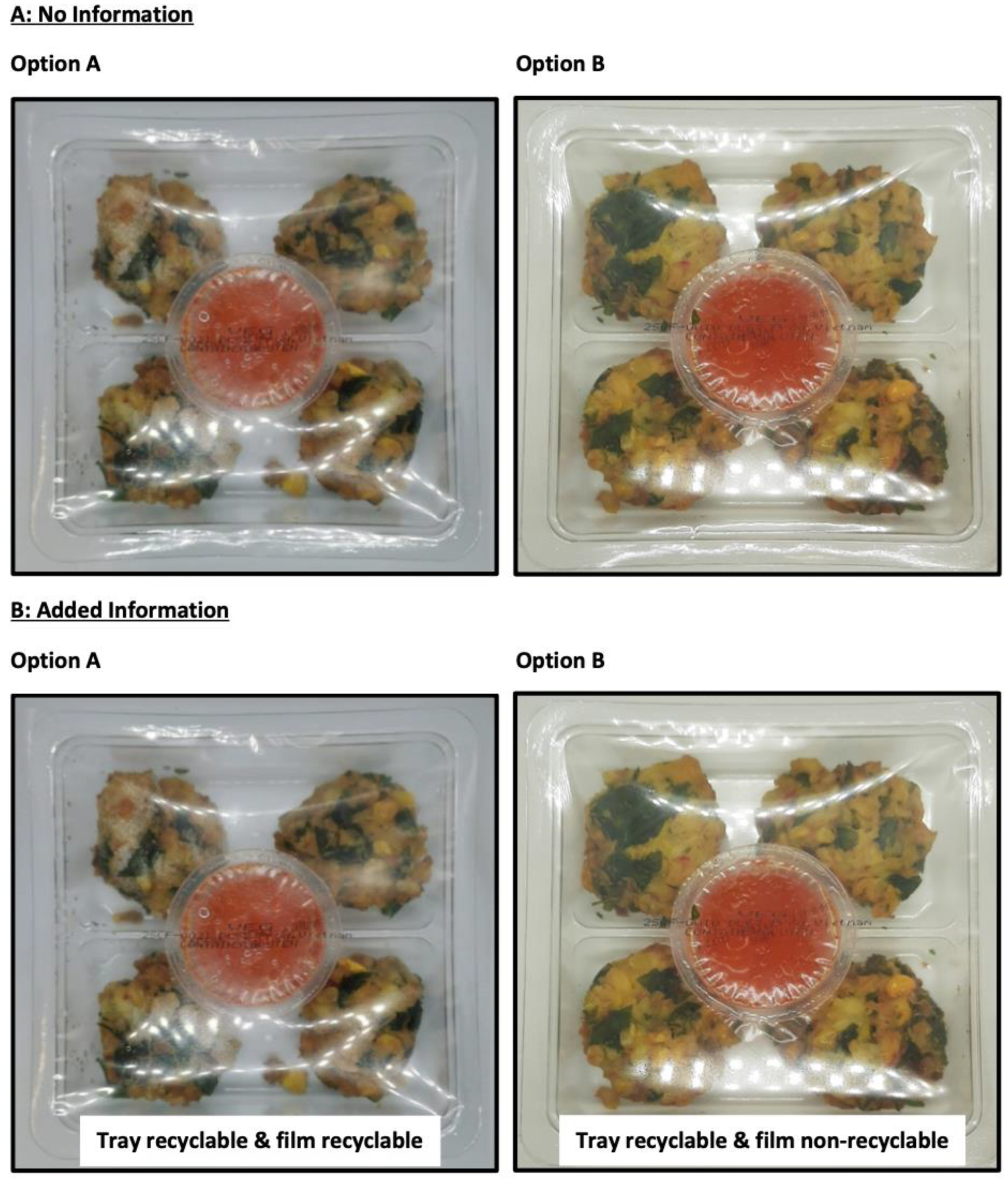

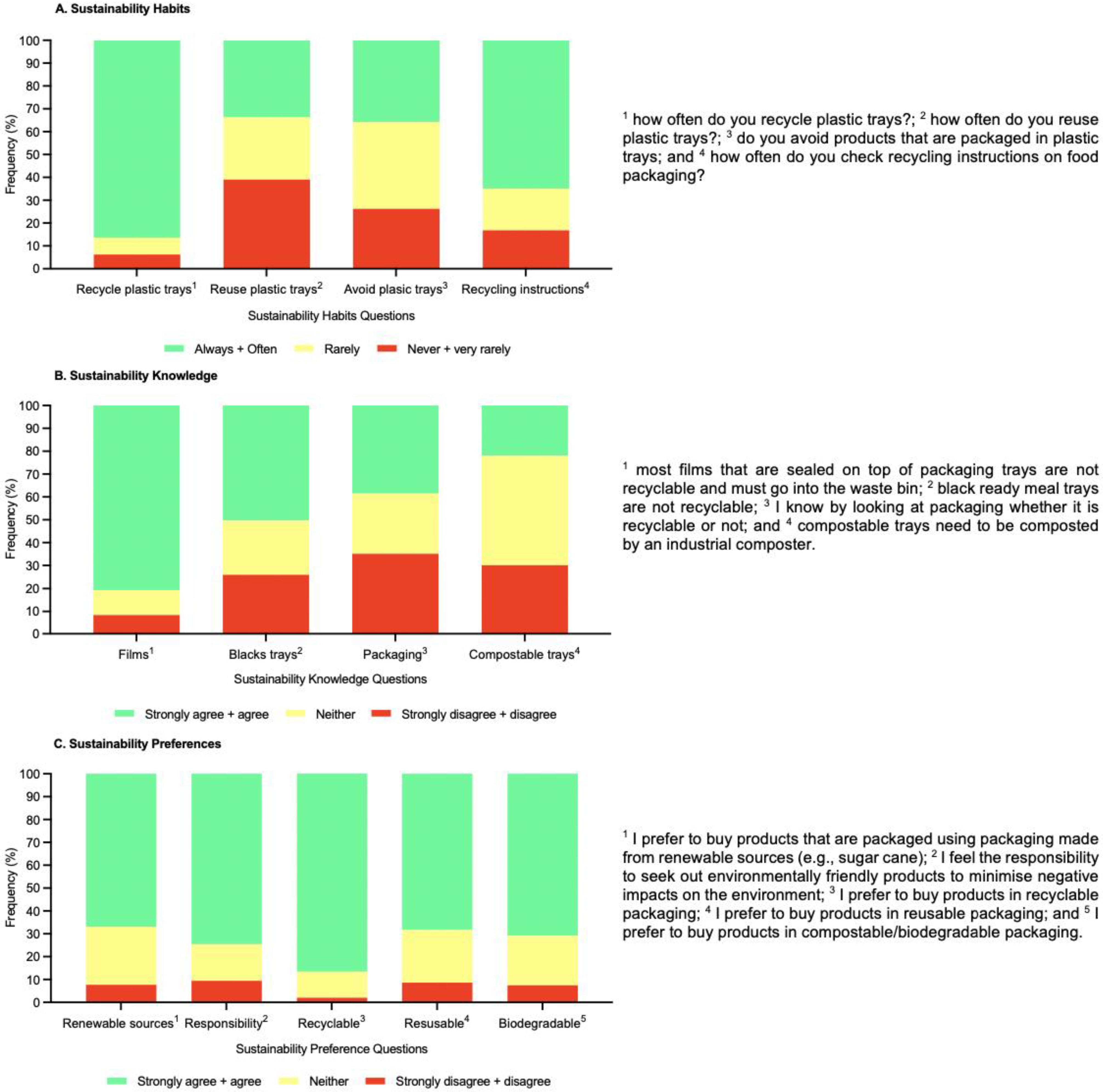
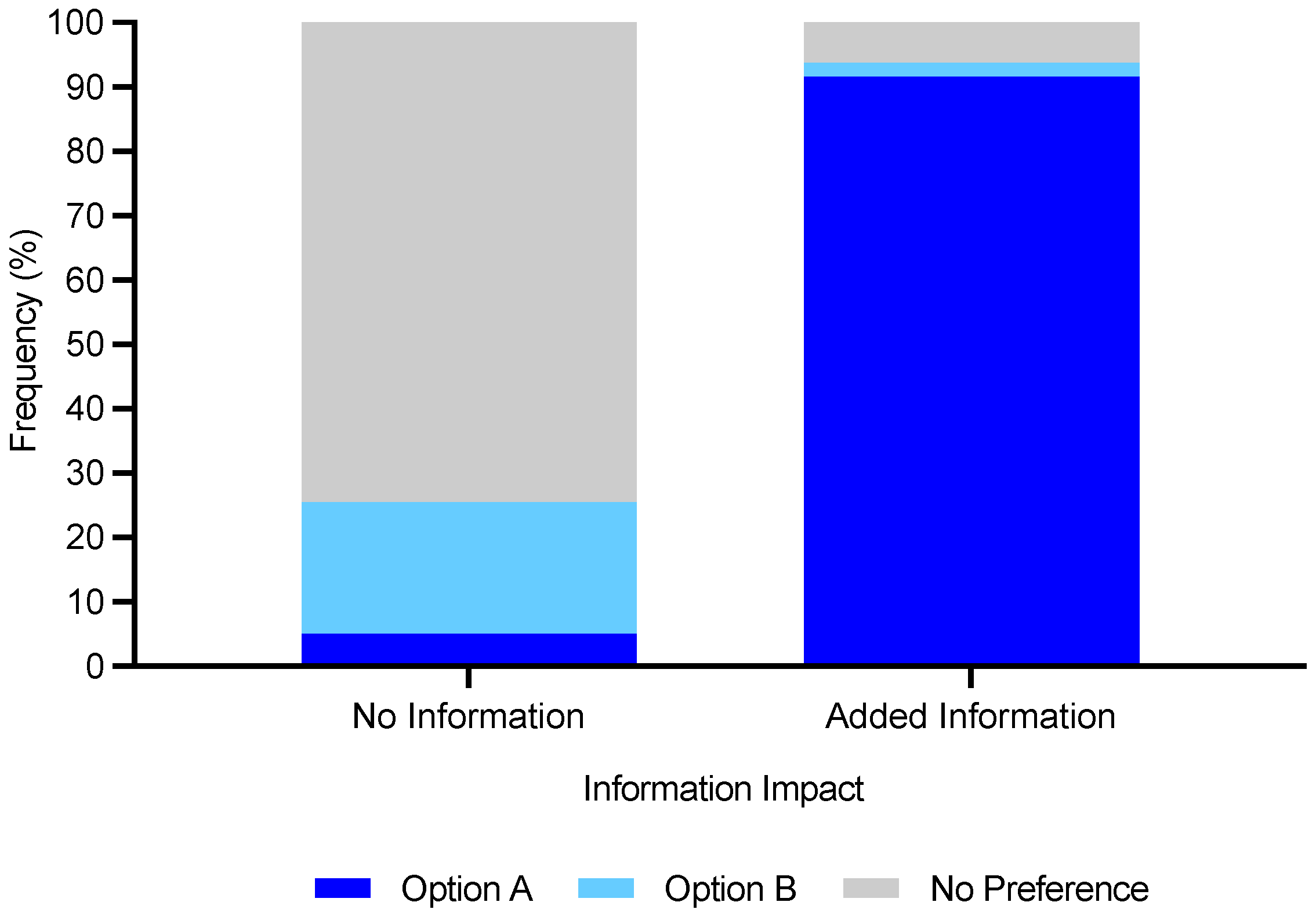
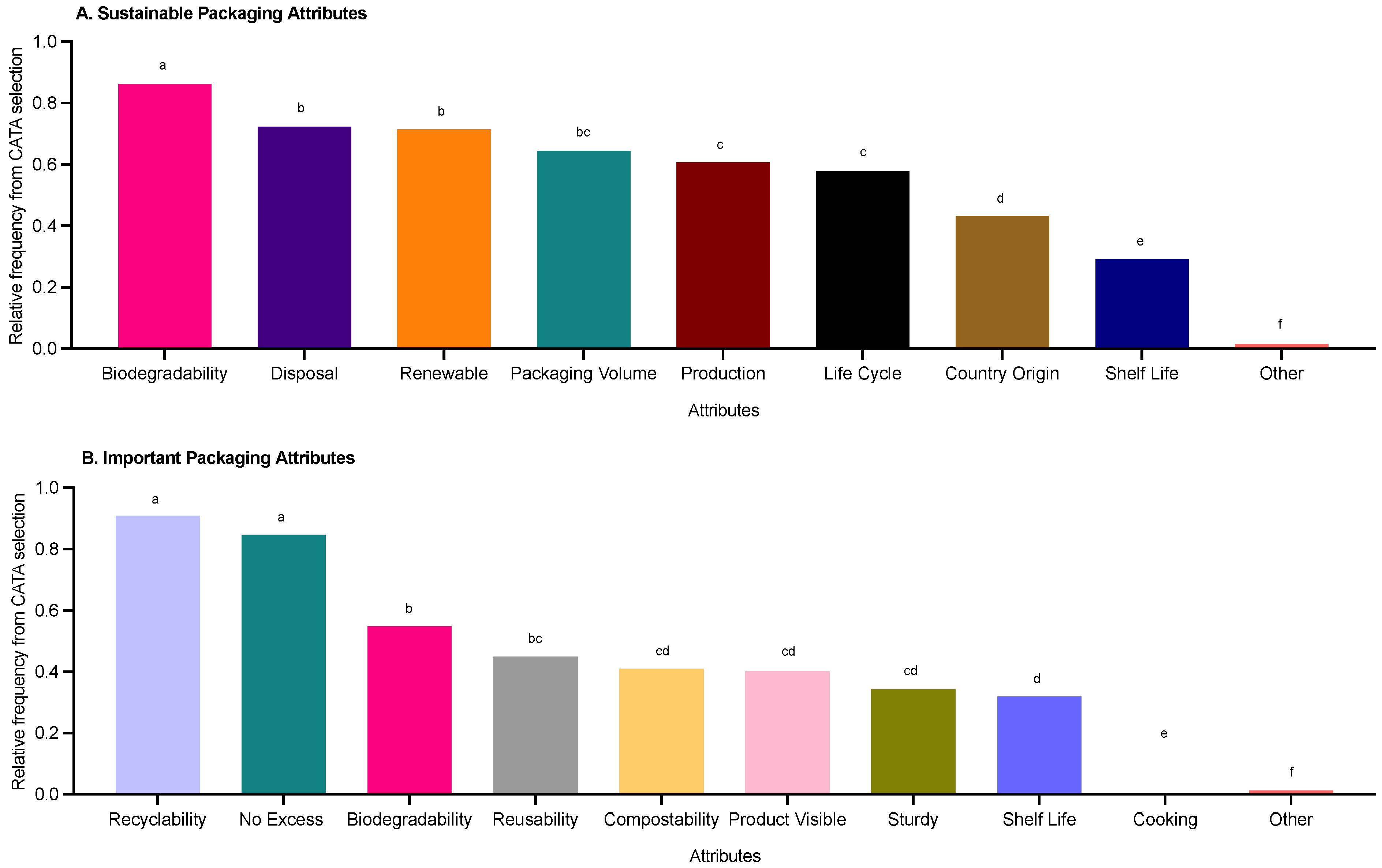

| Food Packaging Materials | Image | Information |
|---|---|---|
| Compostable tray |  | Non-recyclable Non-biodegradable Compostable |
| Clear plastic tray | 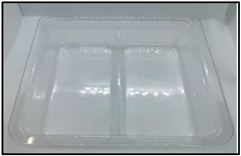 | Widely recyclable Non-biodegradable Non-compostable |
| Recycled plastic tray | 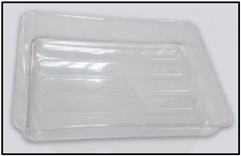 | Widely recyclable Non-biodegradable Non-compostable |
| Bio-based plastic tray * |  | Non-recyclable Sometimes biodegradable Sometimes compostable |
| Bio-based plastic with plastic lining (PL) * |  | Non-recyclable Sometimes biodegradable (tray) Sometimes compostable (tray) Non-biodegradable (PL) Non-compostable (PL) |
| Demographics/Recycling Behaviour | n | % |
|---|---|---|
| Age | ||
| 18–24 | 155 | 38.3 |
| 25–35 | 95 | 23.5 |
| 36–45 | 47 | 11.6 |
| 46–55 | 57 | 14.1 |
| 56–55 | 34 | 8.4 |
| 65+ | 17 | 4.2 |
| Gender | ||
| Female | 313 | 77.3 |
| Male | 88 | 21.7 |
| Other | 4 | 1.0 |
| Education Status | ||
| Doctorate & Master’s | 99 | 24.4 |
| Bachelor’s | 177 | 43.7 |
| Vocational | 15 | 3.7 |
| Secondary | 108 | 26.7 |
| Primary | 1 | 0.2 |
| Other | 5 | 1.2 |
| Employment Status | ||
| Employed | 199 | 49.1 |
| Unemployed | 19 | 4.7 |
| Student | 165 | 40.7 |
| Retired | 22 | 5.4 |
| Environmentally Friendly/Conscious | ||
| Yes | 346 | 85.4 |
| No | 32 | 7.9 |
| Unsure | 27 | 6.7 |
| Do you recycle? | ||
| Yes | 393 | 97.0 |
| No | 12 | 3.0 |
| Material | Normally Recycled 1 | Ranked Recycled 2 | Difference 3 |
|---|---|---|---|
| Relative Frequency | Mean Ranks | ||
| Plastic | 0.97 a | 2.10 a | No change |
| Cardboard | 0.95 a | 2.11 a | No change |
| Metal | 0.95 a | 3.51 b | Decrease |
| Paper | 0.94 a | 3.31 b | Increase |
| Glass | 0.94 a | 4.41 c | No change |
| Food waste | 0.63 b | 5.94 d | No change |
| Garden waste | 0.54 b | 6.95 e | No change |
| Wood | 0.32 c | 7.67 f | No change |
| Other | 0.09 d | - | - |
| Material | No Information | Added Information | Impact on Rank 1 | |||
|---|---|---|---|---|---|---|
| Mean Ranks | Ranking | Mean Ranks | Ranking | Difference | Position | |
| Compostable tray | 1.57 a | 1 | 2.06 a | 1 | 0.49 | No change |
| Bio-based plastic tray * | 1.63 a | 2 | 2.85 b | 3 | 1.22 | Decrease |
| Bio-based plastic tray with plastic labelling | 3.47 b | 3 | 4.64 d | 5 | 1.17 | Decrease |
| Recycled plastic tray | 3.51 b | 4 | 2.14 a | 2 | 1.37 | Increase |
| Clear plastic tray | 4.83 c | 5 | 3.32 c | 4 | 1.51 | Increase |
Publisher’s Note: MDPI stays neutral with regard to jurisdictional claims in published maps and institutional affiliations. |
© 2022 by the authors. Licensee MDPI, Basel, Switzerland. This article is an open access article distributed under the terms and conditions of the Creative Commons Attribution (CC BY) license (https://creativecommons.org/licenses/by/4.0/).
Share and Cite
Norton, V.; Waters, C.; Oloyede, O.O.; Lignou, S. Exploring Consumers’ Understanding and Perception of Sustainable Food Packaging in the UK. Foods 2022, 11, 3424. https://doi.org/10.3390/foods11213424
Norton V, Waters C, Oloyede OO, Lignou S. Exploring Consumers’ Understanding and Perception of Sustainable Food Packaging in the UK. Foods. 2022; 11(21):3424. https://doi.org/10.3390/foods11213424
Chicago/Turabian StyleNorton, Victoria, Carys Waters, Omobolanle O. Oloyede, and Stella Lignou. 2022. "Exploring Consumers’ Understanding and Perception of Sustainable Food Packaging in the UK" Foods 11, no. 21: 3424. https://doi.org/10.3390/foods11213424
APA StyleNorton, V., Waters, C., Oloyede, O. O., & Lignou, S. (2022). Exploring Consumers’ Understanding and Perception of Sustainable Food Packaging in the UK. Foods, 11(21), 3424. https://doi.org/10.3390/foods11213424






